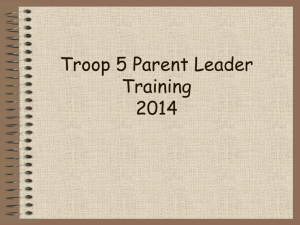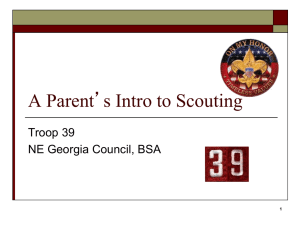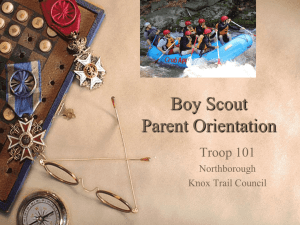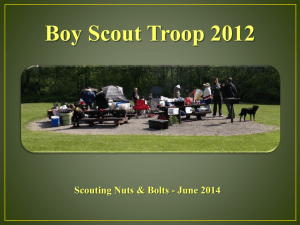Introduction to Leadership Skills for Troops Training Presentation2
advertisement
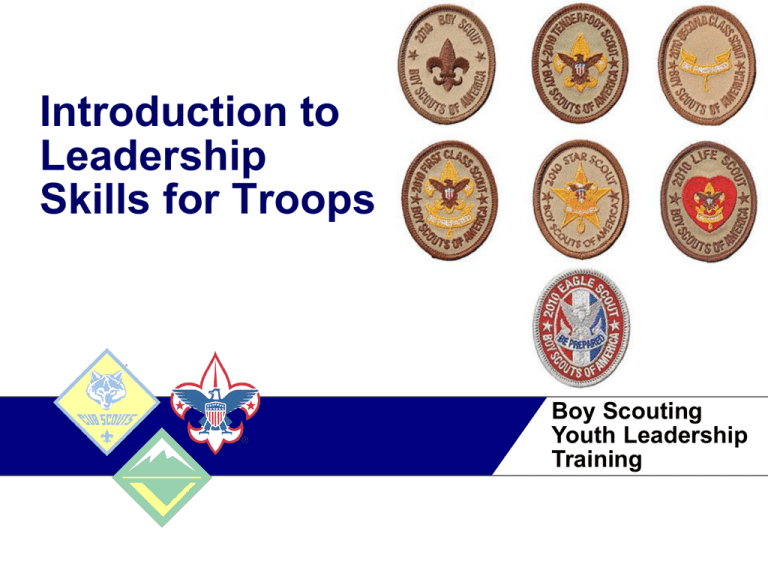
Introduction to Leadership Skills for Troops Boy Scouting Youth Leadership Training 1 Confidential | Copyright © 2009 The TriZetto Group, Inc. Today’s Agenda ► Module One—Troop Organization includes a description of each leadership position in the troop, including roles and responsibilities, troop organization, and introductions to vision and servant leadership. (About an hour…) ► Module Two—Tools of the Trade covers some core skill sets to help the Scout lead, including communicating, planning, and teaching. (About an hour and a half…) ► Module Three—Leadership and Teamwork incorporates additional leadership tools for the Scout, including discussions of teams and team characteristics, the stages of team development and leadership, inclusion/using your team, ethics and values of a leader, and a more in-depth review of vision. (About an hour…) 2 Introduction to this Course ►Leadership in Boy Scouting Leadership is a vital part of the Scouting program. Opportunities to develop leadership skills are a key part of Scouting – every bit as important as rank! Key activities of youth leaders… ► Organizing the troop ► Planning and organizing activities and meetings ► Assigning duties to others ► Planning menus and figuring out food costs ► Encouraging advancement ► Guiding a troop’s involvement in problem-solving 3 ► Teaching outdoor, sports, or craft skills ► Ensuring the troop’s safety during meetings and outings ► Handling the troop’s finances ► Helping other Boy Scouts make the most of their own leadership opportunities ► Encouraging participation Youth Training Continuum Taught at the Council Level Enables Taught at the Unit Level Kodiak is an adventure – to push your boundaries and apply your leadership skills 4 Taught at the Regional/National Level Module One – Unit Organization ►Module Overview 5 Introduction to the Course - 5 minutes Introduction to Vision - 5 to 10 minutes Troop Organization - 20 to 35 minutes The Team-Based Troop - 25 to 30 minutes Introduction to Servant Leadership - 5 to 10 minutes Introduction to the Course ►The purpose of this course ►Where ILST fits into Scouting’s Youth Training Continuum ILST to NYLT to NAYLE ►Course logistics 6 Food Restrooms Breaks Phone calls and cell phone/texting etiquette Introduction to Vision ►Critical to success in any role or project ►Developed and shared by all members ►Share and discuss the vision of the Senior Patrol Leader (SPL) and Scoutmaster 7 Troop Organization ►Organization (chart) for Troop 616 (need to make if not available) ►Note youth alignment to adult positions ►Note the youth positions have responsibilities to one another ►Youth positions are both elected and appointed 8 Scout Positions ►Senior Patrol Leader ►Assistant Senior Patrol Leader ►Patrol Leader ►Assistant Patrol Leader ►Troop Guide ►Den Chief ►Historian ►Librarian 9 ►Order of the Arrow Representative ►Quartermaster ►Scribe ►Instructor ►Chaplain’s Aide ►Webmaster ►LNT Trainer ►Jr. Ass’t Scoutmaster Senior Patrol Leader ► Preside at all troop meetings, events, activities, and annual program planning conference. ► Chair the patrol leaders’ council. ► Appoint Scout leaders with the advice and consent of the Scoutmaster. ► Assign duties and responsibilities to other Scout leaders. ► Work with the Scoutmaster in training Scout leaders. 10 ► Set and enforce the tone for good Scout behavior within the troop. ► Set a good example. ► Wear the Scout uniform correctly. ► Live by the Scout Oath and Scout Law. ► Show and help develop Scout spirit. Assistant Senior Patrol Leader ► Be responsible for training and giving direct leadership to the following appointed Scout leaders: historian, Order of the Arrow troop representative, scribe, librarian, instructor, quartermaster, and chaplain aide ► Help lead meetings and activities as called upon by the senior patrol leader. ► Guide the troop in the senior patrol leader’s absence. 11 ► Perform tasks assigned by the senior patrol leader. ► Function as a member of the patrol leaders’ council. ► Help set and enforce the tone for good Scout behavior within the troop. ► Set a good example. ► Wear the Scout uniform correctly. ► Live by the Scout Oath and Scout Law. Patrol Leader ► Plan and lead patrol meetings and activities. ► Keep patrol members informed. ► Assign each patrol member needed tasks and help them succeed. ► Represent the patrol at all patrol leaders’ council meetings and the annual program planning conference. ► Prepare the patrol to take part in all troop activities. 12 ► Show and help develop patrol spirit. ► Work with other troop leaders to make the troop run well. ► Know what patrol members and other leaders can do. ► Set a good example. ► Wear the Scout uniform correctly. ► Live by the Scout Oath and Scout Law. Assistant Patrol Leader ► Help the patrol leader plan and lead patrol meetings and activities. ► Help the patrol leader keep patrol members informed. ► Help the patrol leader prepare the patrol to take part in all troop activities. ► Lead the patrol in the patrol leader’s absence. ► Show and help develop patrol spirit. 13 ► Represent the patrol at all patrol leaders’ council meetings in the patrol leader’s absence. ► Work with other troop leaders to make the troop run well. ► Set a good example. ► Wear the Scout uniform correctly. ► Live by the Scout Oath and Scout Law. Troop Guide ► Introduce new Scouts to troop operations. ► Guide new Scouts through early Scouting activities. ► Help set and enforce the tone for good Scout behavior within the troop. ► Ensure older Scouts never harass or bully new Scouts. ► Help new Scouts earn the First Class rank in their first year. ► Coach the patrol leader of the new-Scout patrol on his duties. ► Work with the patrol leader at patrol leaders’ council meetings. 14 ► Attend patrol leaders’ council meetings with the patrol leader of the new-Scout patrol. ► Assist the assistant Scoutmaster with training. ► Coach individual Scouts on Scouting challenges. ► Set a good example. ► Wear the Scout uniform correctly. ► Live by the Scout Oath and Scout Law. ► Show and help develop Scout Den Chief ► Serve as the activities assistant at den meetings. ► Meet regularly with the den leader to review the den and pack meeting plans. ► If serving as a Webelos den chief; help prepare boys to join Boy Scouting. ► Project a positive image of Boy Scouting. 15 ► Set a good example. ► Wear the Scout uniform correctly. ► Live by the Scout Oath and Scout Law. ► Show and help develop Scout spirit. Historian ► Gather pictures and facts about past activities of the troop and keep them in scrapbooks, wall displays, or information files. ► Take care of troop trophies and keepsakes. ► Keep information about troop alumni. ► Set a good example. 16 ► Set a good example. ► Wear the Scout uniform correctly. ► Live by the Scout Oath and Scout Law. ► Show and help develop Scout spirit. Order of the Arrow Troop Representative ► Serve as a communication link between the lodge or chapter and the troop. ► Encourage year-round and resident camping in the troop. ► Encourage older-Scout participation in high-adventure programs. ► Encourage Scouts to actively participate in community service projects. ► Assist with leadership skills training in the troop. ► Encourage Arrowmen to assume leadership positions in the troop. 17 ► Encourage Arrowmen in the troop to be active participants in lodge and/or chapter activities and to seal their membership in the Order by becoming Brotherhood members. ► Set a good example. ► Wear the Scout uniform correctly. ► Live by the Scout Oath, Scout Law, and OA Obligation. ► Show and help develop Scout spirit. Librarian ► Establish and maintain a troop library. ► Keep records on literature owned by the troop. ► Add new or replacement items as needed. ► Have literature available for borrowing at troop meetings. ► Maintain a system to check literature in and out. 18 ► Follow up on late returns. ► Set a good example. ► Wear the Scout uniform correctly. ► Live by the Scout Oath and Scout Law. ► Show and help develop Scout spirit. Quartermaster ► Keep records of patrol and troop equipment. ► Keep equipment in good repair. ► Keep equipment storage area neat an ► Issue equipment and see that it is returned in good order. ► Suggest new or replacement items. 19 ► Work with the troop committee member responsible for equipment. ► Set a good example. ► Wear the Scout uniform correctly. ► Live by the Scout Oath and Scout Law. ► Show and help develop Scout spirit. Scribe ► Attend and keep a log of patrol leaders’ council meetings. ► Record attendance and dues payments of all troop members. ► Record advancement in troop records and on the troop advancement chart. ► Set a good example. ► Wear the Scout uniform correctly. 20 ► Work with the appropriate troop committee members responsible for finance, records, and advancement. ► Live by the Scout Oath and Scout Law. ► Show and help develop Scout spirit. ► Handle correspondence appropriately. Instructor ► Instruct Scouting skills as needed within the troop or patrols. ► Prepare well in advance for each teaching assignment. ► Set a good example. 21 ► Wear the Scout uniform correctly. ► Live by the Scout Oath and Scout Law. ► Show and help develop Scout spirit. Chaplain’s Aide ► Keep troop leaders apprised of religious holidays when planning activities. ► Assist the troop chaplain or religious coordinator in meeting the religious needs of troop members while on activities. ► Encourage saying grace at meals while camping or on activities. ► Lead worship services on campouts. 22 ► Tell troop members about the religious emblems program for their faith. ► Set a good example. ► Wear the Scout uniform correctly. ► Live by the Scout Oath and Scout Law. ► Show and help develop Scout spirit. Webmaster ► Establish and maintain a safe and secure troop website. ► Ensure the troop website is a positive reflection of Scouting for the public. ► Manage the troop’s electronic communication tools. ► Work with the Scouts to provide up-to-date troop information. 23 ► Work with the scribe. ► Set a good example. ► Wear the Scout uniform correctly. ► Live by the Scout Oath and Scout Law. ► Show and help develop Scout spirit. Leave No Trace Trainer ► Have a thorough understanding of and commitment to Leave No Trace. ► Successfully complete the Leave No Trace Trainer training course. ► Help minimize the troop’s impact on the land by teaching Scouts the principles of Leave No Trace. ► Help ensure that the troop follows Leave No Trace principles on outings. 24 ► Set a good example. ► Wear the Scout uniform correctly. ► Live by the Scout Oath and Scout Law. ► Show and help develop Scout spirit. Junior Assistant Scoutmaster ► Function as an assistant Scoutmaster (except for leadership responsibilities reserved for adults 18 and 21 years of age or older). ► Accomplish any duties assigned by the Scoutmaster. ► Set a good example. 25 ► Wear the Scout uniform correctly. ► Live by the Scout Oath and Scout Law. ► Show and help develop Scout spirit. Adult Troop Positions ►Adults in the troop are responsible for providing training to troop leadership and enabling them to carry out their duties. ►They also provide resources for the troop leaders and serve as mentors to all Scouts in the troop. ►The number of adult leaders and committee members needed is dependent on the size and needs of the troop. 26 Scoutmaster ► Train and guide boy leaders. ► Work with other responsible adults to bring Scouting to boys. ► Use the methods of Scouting to achieve the aims of Scouting. ► Meet regularly with the patrol leaders’ council for training and coordination in planning troop activities. ► Attend all troop meetings or, when necessary, arrange for a qualified adult substitute. ► Attend troop committee meetings. ► Conduct Scoutmaster conferences for all rank advancement. 27 ► Conduct periodic parents’ sessions to share the program and encourage parent participation and cooperation. ► Provide a systematic recruiting plan for new members and see that they are promptly registered. ► Delegate responsibility to other adults and groups (assistants, troop committee) so they have a real part in troop operations. ► Conduct all activities under qualified leadership, safe conditions, and the policies of the chartered organization and the Boy Scouts of America. Assistant Scoutmasters ► To fulfill his or her obligation to the troop, the Scoutmaster, with the assistance of the troop committee, recruits assistant Scoutmasters to help operate the troop. ► Each assistant Scoutmaster is assigned specific program duties and reports to the Scoutmaster. ► They also provide the two-deep leadership required by the Boy Scouts of America (there must be at least two adults present at any Boy Scout activity). ► An assistant Scoutmaster may be 18 years old, but at least one in each troop should be 21 or older so he or she can serve in the Scoutmaster’s absence. 28 Committee Chair ► Supervises the Scoutmaster and committee members. ► Recruits and approves Scoutmasters and committee members. 29 Committee Member ► ► ► ► Serves as a resource to the troop. Works with an assigned officer. Recruits consultants. Potential Roles 30 Webmaster Treasurer Secretary Merit Badge Coordinator Quartermaster Eagle Scout Coordinator Camping Coordinator Chatered Organization Representative ► Serves as the liaison between the troop and the chartered organization. ► Recruits the troop committee; approves Scoutmasters and committee members. ► Participates in district leadership. 31 Roles & Responsibilities - Breakout ►Role Balancing – Balloon Toss (See ILST pg 18) Reflection…(See ILST pg 19) 32 The Scout-Led Troop (See ILST pg 19) ►Group Discussion: Leadership in Scouting Discuss leadership in Scouting and the value of the Scout-led troop ►Game: Yurt Circle Reflection: Key teaching points: 33 The Scout-Led Troop ►Group Discussion: Patrol Leader’s Council ►Game: Helium Stick Reflection: Key points: 34 The Scout-Led Troop ►Group Discussion: Define leadership ►Group Discussion: Tips for Being a Good Leader in the Troop ►Game: Willow in the Wind (See ILST pg 22) 35 Introduction to Servant Leadership (See ILST pg 22-23) ►Group Discussion: Why Should Scouts Choose to Be Leaders? A choice to lead an a choice to give rather than receive. Reflection: (Servant Leadership) Key points: 36 Take 10 minutes… BREAK! 37 Module Two– Tools of the Trade ►Module Overview 38 Introduction to the Tools of the Trade Session – 5 mins Communications – 20 to 30 minutes Planning – 20 to 30 minutes The Teaching EDGE – 15 to 25 minutes Introduction to the Tools of the Trade ►Communications – The skills of being an effective listener and an effective communicator are valuable tools for any leader. ►Planning – Proper planning makes the difference in almost all Scouting activities. ►Teaching EDGE – The Teaching EDGE method can be used any time a leader is helping others learn. 39 Communications ►Basic Parts of ANY communication: A sender A message A receiver This is still a valid model today. It applies to all forms of communication: verbal, written, music, film, signaling, pantomime, teaching, etc. ►Game: Receiving Reflection: Key points: 40 Key Listening Tips: ► Listen with your eyes as well as with your ears. Watch for nonverbal cues. ► Avoid distractions, both physical and mental. Give the speaker your full attention. ► Try to see things from the speaker’s point of view. In other words, try to put yourself in the speaker’s shoes. ► Apply the ideas to yourself. Think about how the speaker’s message relates to you and your experiences. ► Ask questions if you are unclear about anything. 41 ► Review the speaker’s points and think what logically might come next in the message. ► Curb your desire to talk until the speaker has finished. ► Respond nonverbally (nod your head or smile) to the speaker. ► Practice listening with respect for the speaker. Work hard not to interrupt even when you have a burning desire to make a point. Effective Messages ►Game: The Whole Picture (See ILST pg 26) Reflection: 42 Effective Messages - Tips ►Organize your thoughts ►Minimize distractions ►Get the audience’s attention first ►Speak clearly and make eye contact ►Repeat facts such as dates, times, and places. ►Distribute notes 43 Planning ►Second only to communicating, good planning is an essential skill for every effective leader. At its core, planning is really just thinking ahead ►Ask questions – develop answers ►After initial planning (also called “happy path” planning), start asking “what if” questions Adjust your plan to accommodate the unexpected Next add the “who” – the resources to make it happen 44 Planning ►Group Exercise: Planning Plan as a group a sample troop service project Scenario: On a Saturday, six weeks from now, the troop will conduct a service project at a local city park. The project involves: Installing 50 feet of split-rail fence around a tree (to protect it) Removing old plants and undergrowth from a nearby area (approximately 500 square feet in area). Laying down weed block in the cleared area. Spreading 6 cubic yards of mulch in the area just cleared and under the fenced-in tree Planting 15 to 20 small plants and shrubs in a small garden in a third area nearby 45 Planning (exercise) ►Task: Plan what equipment you need for the project and how you’re going to get it. Plan how to use and manage your team on the day of the project. Reflection – about the planning session Reflection – about the project Key points: 46 Teaching EDGE ►The EDGE (Explain, Demonstrate, Guide, Enable) method is the primary training method to teach skills in the troop. ►EDGE should be used for all teaching opportunities. Make it a habit. ►It can be used anytime a leader is helping others learn. 47 The Four-Step EDGE Process 1. Explain -The trainer explains how something is done. 2. Demonstrate - After the trainer explains, the trainer demonstrates while explaining again. This gives the learner a clear understanding of what success looks like. 3. Guide - The learner tries the skill while the trainer guides him through it. The trainer gives instant feedback as the learner practices the skill. 4. Enable - The learner works independently under the watchful eye of the trainer. The trainer helps remove any obstacles to success, thus enabling the learner to succeed. ► Sample skill instruction ► Reflection: 48 Tools of the Trade (Wrap-up) ►Communications, planning, and teaching — are core skills leaders can use any time they are working with their team ►Good planning is foundational to everything ►As you grow in Scouting and take on more leadership roles, your leadership skills and strengths will continue to grow over time. 49 Take 15 minutes… BREAK! 50 Module Three – Leadership & Teamwork ►Module Overview Introduction to Leadership and Teamwork Session - 5 minutes Teams and Team Characteristics - 5 to 10 minutes Stages of Team Development and Styles of Leadership - 15 to 25 minutes Inclusion - 10 to 15 minutes Leadership Ethics and Values - 15 to 25 minutes Vision - 5 minutes Wrap Up the Introduction to Leadership Skills for Troops Course - 5 minutes 51 Introduction to Leadership and Teamwork Session ►Discussion: What do we mean by “team”? Characteristics of effective teams? (list on a board) 52 Stages of Team Development ►Discussion: How do teams develop? Review team development through a discussion 53 Where the Group Is ►Stages: Starting out (skills are low, enthusiasm is high) Becoming discouraged (skills and enthusiasm are low) Making progress (skills and enthusiasm is rising) Finding success (skills and enthusiasm are high) ►Team Skill Level and Enthusiasm Skill Level – rises over time Enthusiasm – varies as the team develops ► Discussion: How can the leader affect the team’s development? 54 Inclusion Effective engagement, inclusion and the use of each member of your team is an important skill Discussion: The Potato Game Reflection: 55 Inclusion (Rocks) 56 Leadership Ethics and Values ►Discussion: Scout Oath 57 “On my honor…” “…I will do my best…” “…to do my duty…” “…to God and my country…” “… and to obey the Scout Law…” “…to help other people at all times…” …to keep myself physically strong…” “…mentally awake…” “…and morally straight.” Leadership Ethics and Values ►Discussion: Scout Law 58 A Leader is... Trustworthy, A Leader is... Loyal, A Leader is... Helpful, A Leader is... Friendly, A Leader is... Courteous, A Leader is... Kind, A Leader is... Obedient, A Leader is... Cheerful, A Leader is... Thrifty, A Leader is... Brave, A Leader is... Clean, A Leader is... and Reverent. Leadership Ethics and Values ►Did you know you’ve been playing the Integrity Game? Leader comments… 59 Leadership Ethics and Values ►The Servant Leader 60 Relationship between a leader and the team? The role of a leader Recognizing responsibilities A leader enables the success of the team Good and bad examples of leadership Be tuned in to the needs and communications of the team Leadership Ethics and Values ►Servant Leaders: Need to listen and know when the time for discussion is over. Achieve consensus and know when to preserve things that are good without foundering in a constant storm of question and reinvention. Set/maintain standards and know when to reject what does not maintain those standards or the team vision. Serve their customers and know how to make a difference with the team. 61 Vision ►Discussion: What is YOUR Vision of Success for Troop 88? How will we use our leadership skills to reach this success? How can we support our new Scout leaders achieve their goals and be successful? 62 Wrap-Up to the Course ►Thanks for attending! ►Bring this new enthusiasm and training to your roles and your patrols ►Use the other leaders around you ►Make a difference! 63 QUESTIONS? Boy Scouting Youth Leadership Training 64 Confidential | Copyright © 2009 The TriZetto Group, Inc.
